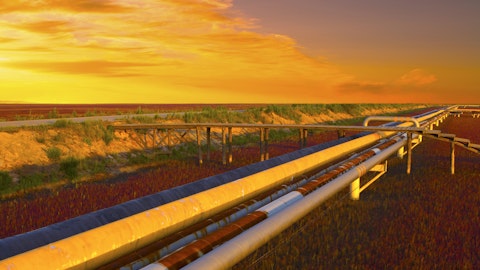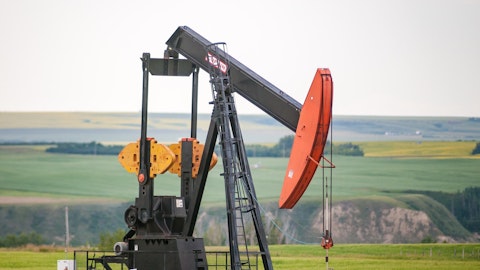Intrepid Potash, Inc. (NYSE:IPI) Q4 2022 Earnings Call Transcript March 7, 2023
Operator: Thank you for standing by. This is the conference operator. Welcome to the Intrepid Potash Inc. Fourth Quarter 2022 Results Conference Call. I would now like to turn the conference over to Evan Mapes, Investor Relations. Please go ahead.
Evan Mapes: Thank you, Chris. Good morning, everyone. Thanks for joining us to discuss and review Intrepid’s fourth quarter 2022 results. With me today is Intrepid’s Co-Founder, Executive Chairman and CEO, Bob Jornayvaz and CFO, Matt Preston. Also with me today and available to answer questions during the Q&A session following our prepared remarks is our Vice President of Sales and Marketing, Zachary Adams. Please be advised that our remarks today, including answers to your questions include forward-looking statements as defined by U.S. securities laws. These forward-looking statements are subject to risks and uncertainties that could arise that could cause actual results to be materially different from those currently anticipated.
These statements are based on the information available to us today and we assume no obligation to update them. These risks and uncertainties are described in our periodic reports filed with the SEC, which are incorporated here by reference. During today’s call, we will refer to certain non-GAAP financial and operational measures. Reconciliations of these non-GAAP financial measures to the mostly directly comparable GAAP measures are included in yesterday’s press release. Our SEC filings and press releases are available on our website at intrepidpotash.com. I will now turn the call over to Bob.
Bob Jornayvaz: Thank you, Evan and good morning to everyone joining our fourth quarter 2022 earnings call. We appreciate your attendance and your interest in Intrepid. Before getting to our fourth quarter results, I will begin my remarks with some commentary on the current state of the potash market. Over the past 18 months, we have witnessed several extraordinary events, two rounds of U.S sanctions targeting the Belarusian potash industry, the EU and other countries adopting comparable measures, effectively removing Belarusian potash from Western markets, and three Russians invasion of Ukraine in continued conflict. The resulting effect on the potash market has been high volatility and pricing, uncertainty around global production and exports and a good reminder of the importance of having access to reliable supplies.
While the second half of 2022 was slower than expected, we want to emphasize that we begin 2023 with a supply constrained potash market, where an estimated 25% to 30% of global 2023 potash production is still coming from higher risk regions in Eastern Europe, which is showing minimal signs and deescalation. In the 2023 potash supply demand equation, supply is still tight and we think demand will show a solid rebound. Following that market overview, I will now provide a quick recap of our 2022 financial performance. During 2022, we generated adjusted EBITDA of approximately $142 million, while our adjusted net income totaled approximately $80 million. This financial performance is among the best in company history, with the key driver obviously being higher prices for our fertilizer products.
Our 2022 average net realized sales price for potash was $713 per ton, up over 100% compared to the prior year. And for Trio, our average net realized sales price was $479 per ton, up over 60% compared to 2021. In 2022, our cash flow from operations totaled $89 million, which is net of the third quarter $33 million customer refund. Our approach to using the strong cash generation was number one to begin investments in numerous of our potash growth projects with the goal of increasing our production and improving our per unit economics directly benefiting from our solar solution mines, the HB, Moab and Wendover. Secondly to reward our shareholders with some of the cash returning roughly $22 million in capital in the form of share repurchases, which reduce our shares outstanding by roughly 5%.
For 2023, we plan to continue to invest in our potash assets to help ensure that our solar solution mines have more reliable high-grade brine. As a higher fixed cost business, increased potash production can drive significant improvements on the cost side of our unit economics and more reliable higher grade brine will help reduce production variances and sustain cash generation throughout the cycle, which will allow us to fully take advantage of our potash assets, which have remaining reserved lives measured in many decades. We strongly believe now is the time to invest in these high-quality assets. As for where we stand today, potash pricing is back at levels where buyers are finding good value and we have seen a strong start to 2023 as farmers prepare for the spring application season.
During the back half of 2022, fertilizer affordability was a primary concern for farmers. However, their economics today are very good, particularly in the context of where futures have been trading. The forward curves for most commodities look extremely strong. As start of January new crop features for corn traded just over $6 per bushel, which is the highest level in the last 20 years for the first trading day of the year. Soybeans were similar with new crop soybeans trading just under $14 per bushel, also the highest level in 20 years for the first trading day of the year. Current futures prices for corn and soybeans are even higher trading at roughly $6.50 per bushel and $15.50 per bushel respectively, with the new crop futures still trading at similar levels that we saw at the beginning of January 2023.
Offering further support to futures prices, global and U.S. crop inventory levels are both at historically low levels. One region the market has been closely watching this year is Argentina and Brazil, corn and soybean production. While Brazil is still projected to have a very strong production year, Argentina has been experiencing a severe drought and even soft frost in the middle of February, which is putting downward pressure on the country’s production estimates. Lastly, given where potash is now trading compared to crop prices, we are now seeing fertilizer affordability ratios back in line to more normal levels, which we believe will lead to strong application rates throughout the spring. To summarize my prepared remarks, global potash supply demand is still a supply constrained markets with supply concerns and higher risk areas like Eastern Europe, obviously present.
The futures market today for key crops is very strong and much better than we have seen historically. And three, potash affordability looks fine in the eyes of the U.S. farmer. The farmer we believe is ready to buy. Consequently, these farmers should be highly incentivized to maximize their yields this year, which in turn should drive steady demand for our key products throughout 2023. I’ll now turn the call over to Matt. Please go ahead.
Matt Preston: Thanks Bob. The solid financial performance that Intrepid delivered throughout 2022 continued into the fourth quarter, with the company generating adjusted net income of approximately $11 million and adjusted EBITDA of $23 million. As noted in our press release yesterday, fourth quarter results are impacted by the failure and resulting plug and abandonment of a new extraction well at HB. This will reduce the quality of brine available at our HB facility for the upcoming summer evaporation season. And we estimate our calendar year 2023 production will be similar to 2022 at approximately 260,000 tons. As Bob noted, the key driver behind our strong performance continues to be high prices for potash and Trio and in the fourth quarter our average net sales price for potash was $693 per ton, while for Trio, it averaged $461 per ton.
We saw some of our agricultural customers defer fertilizer purchase decisions until the announcement of the fill program in early January 2023, although our diverse sales mix in defeat and industrial helped drive another quarter of strong netbacks for Intrepid. In our potash segment, our fourth quarter 2022 sales volumes totaled 50,000 tons while our production totaled 106,000 tons, which compares to a year ago figures of 61,000 tons and 86,000 tons respectively. For 2022, our sales volumes totaled 222,000 tons while our production totaled 270,000 tons, which compares to 331,000 tons and 287,000 tons of production last year. In our potash segment, our weighted average carrying cost per ton increased due to reduced production rates, increase per ton royalty expense, and other general inflationary pressures.
In terms of potash guidance for the first quarter of 23, we expect Q1 sales volumes in the range of 80,000 to 90,000 tons with an average net realized sales price $470 to $480 per ton. In our Trio segment, our fourth quarter of 2022 sales volumes totaled 28,000 tons, down from 48,000 tons in the prior year period as buyers remain reluctant to commit to volumes in anticipation of declining prices. Our production totaled 51,000 tons, down slightly from 53,000 tons in the fourth quarter of 21. For full year 22 our production was down just slightly at 226,000 tons, while total sales volumes of 197,000 tons were down about 80% year-over-year. As for Trio guidance, we expect first quarter 2023 sales volumes will fall in the range of 55,000 to 65,000 tons, with an average net realized sales price between $335 and $345 per ton.
In oilfield solutions, our total sales increased from approximately $23 million in 21 to $29 million in 2022, with our 2022 gross margin coming in at $7.5 million, up from $3.5 million in the prior year. In general, performance in this segment correlates closely with oilfield activity in the Permian. Last year, we saw horizontal Permian rigs increase from about 275 rigs at the beginning of 2022 to roughly 335 by the end of the year and monthly completion activity increased from 409 wells in January of 22 peak at 449 in June and end the year at 431 wells completed in December. So far in 23 Permian activity has been trending flat to slightly up. Moving to our 2023 capital program, as Bob mentioned, our focus remains on increasing the production and reliability at our solar solution mines.
Our 2023 capital budget range is $60 million to $75 million, with approximately $25 million to $35 million for sustaining capital and the remainder for growth projects. At our HB facility, the installation of an improved pipeline system is progressing well. And after some small permitting delays due to rail crossings, we expect the first set of infrastructure to be in place in the second quarter, which will increase our injection rig capabilities into the mine. The second phase of the project, which includes an in-line cleanup process to help maintain injection rates, is currently being permitted and we hope to begin installation of that infrastructure near the end of the year. We also expect to drill another extraction well in the second half of 2023 to access a significant pool of high-grade brine that we originally targeted in the fourth quarter of 2022.
At Moab, the additional potash cavern is also on track and by mid-March, we expect the first of four laterals will be complete. We made the decision to expand the well design from two horizontal laterals to four laterals, which was slightly extended the timeline, although we still expect brine in time for the summer evaporation season. Once the cavern is complete, we anticipate moving the drilling rig over to drill multiple sump wells, access additional high-grade brine for the summer evaporation season. As a final reminder, while we progress through our potash growth projects, given the cycle of brine injection residence time underground, and summer evaporation harvests. This does take some time before we see these investments payoff in the form of sustained higher production and ultimately increased tons sold.
Operator, we are now ready to take for the Q&A portion of the call.
Q&A Session
Follow Intrepid Potash Inc. (NYSE:IPI)
Follow Intrepid Potash Inc. (NYSE:IPI)
Operator: The first question is from Josh Spector with UBS. Your line is open.
Lucas Beaumont: Good morning. This is Lucas Beaumont on for Josh. Yes, just wanted to start on the potash production. So you sort of mentioned that you are expecting 260 tons this year now. But I mean, you have got the projects that are coming in the second half to try and sort of improve the realization there. So could you maybe just kind of walk us through how you see your pathway now over the next couple of years to kind of get back to that sort of 320, 330 sort of ton production runs in your head historically?
Bob Jornayvaz: Yes, this is Bob I’ll walk you through at HB. The building of the pipeline injection system, which allows us to increase injectivity, which in turn, increases the mining that happens underground in the abandoned potash mines, which in turn increases the brine grades. As we said, we drilled a dry hole, if you will. It was a mechanical failure. And so we will replace that well in the third quarter and we believe we will have that brine back on. We know that there is 800 million to 1 billion barrels of 10% brine sitting in that pool. And so we simply need to access it. That’s at HB. So the combination of the infrastructure and the additional wells will get us where we need to be with brine at HB. At Moab we are drilling cavern 4 right now, which is a four lateral cavern system.
First platter was complete. It’s been a very successful cavern in terms of being in the potash will begin the undercutting of that pier within days, start pumping brine into the ponds before we start on with lateral two. We will move from that drill what are some pretty significant sumps in potash five in the original Texas Gulf mine. So we will drill those we will keep that Aztec rig and just skid it over and drilled 4 laterals into the old mine to collect some high-grade brine we know exists there. And then we have made the investments at Wendover. We have had the precipitation of Wendover that we need to have the brine to have a successful production season at Wendover. So we are extremely focused on our solution, our solar solution facilities at HB, Moab and Wendover to get our brine grades as high as they can be to take out as much variability increase that production.
Lucas Beaumont: Great, thanks. And then, I mean, from your outlook comments, it sounds like you generally agree that the global market is going to remain structurally challenged this year. I mean, we sort of estimate it’s going to be short, at least 5 million tons and likely more sort of depending how you kind of measure demand there. So, I was just wondering how you guys thinking about that flowing through into seasonal pricing trends this year? So you kind of outperformed on pricing in the fourth quarter? It seems like that’s going to sort of reset a bit in the first quarter here. But are you expecting spot pricing to move up between sort of here in May and how do you kind of see the outlook progressing through year?
Bob Jornayvaz: As you know, we are a price taker. And so but if we look at fundamentals, if we look at the supply constrained nature of the market, and the incredible economics that farmers had a record year in 2022 and now I am talking globally and globally, farmers have an opportunity given the forward price curves to have a great 2023. So they’ve got every justification and reason to maximize yields. So when we look at our underlying fundamentals of farmers that have great economics, regardless of the crop that we’re talking about, and we’ve got a supply constrained market, there is no reason for this market not to remain as strong as it is today, if not have upward pressure on pricing. It’s we are just in a bullish supply-demand situation. And the fundamentals are strong. And just that’s what we believe. And I think the statistics back us up on that.
Lucas Beaumont: Great. Thanks. Maybe just one more on the cost side, then I will pass it on. So, just trying to think through sort of the step-up sort of in potash cash costs over the last sort of 2 years, I mean it’s moved up kind of about $80 a ton. I mean obviously, a large portion of this is just kind of on the absorption issues on the lower volume. But I am assuming as with everyone else, you guys are probably having some higher structural inflation cost components in there as well. So, I was just wondering if you could kind of break that out for us somehow sort of between sort of what you think is sort of absorption versus any structural kind of increasing costs, and then what you think is kind of recoverable as we sort of move out a year or 2 years, and you kind of get your production sort of back to more traditional levels?
Matt Preston: Yes. No, Lucas, a great question. Certainly a lot of that, that increase in costs has just been due to the fixed cost nature of some of our mines and just that lower production rate we are seeing. Certainly, we are not going to see much abatement on that in 2023 as we continue to see some minor inflationary pressures continuing into early 23 and then obviously, offset a little bit by reduced royalty expense. Kind of as we move out, not ready to give a whole lot of guidance as far as pricing, but certainly is that, overall production number continues to increase into the low-300s, mid-300s. We should see a pretty sizable improvement in our per ton kind of unit economics.
Lucas Beaumont: Got it. Thank you.
Operator: The next question is from Vincent Andrews with Morgan Stanley. Your line is open.
Will Tang: Hi guys, this is Will Tang on for Vincent. Thanks for taking my question here. I am wondering if you can walk us through what you are seeing in the frac sand market that’s giving you confidence to increase the size of the plants that have mined tons per year? And then I believe previously, you are targeting something like $20 to $30 per ton of margin from sand, is that still how we should be thinking about it?
Bob Jornayvaz: From frac sand, right now, we have defined the reserve with additional core holes, and so the reserve is bigger than we originally thought at the Bennett location. In terms of demand for that sand, we have had numerous discussions with supply companies, frac companies etcetera and are currently negotiating with those companies, off-take agreements, if you will. We are still waiting on permitting, as being the first frac sand operation in Southeast New Mexico, the permitting is taking much longer than we thought. But it’s the reliability of the reserves that we feel so confident about, because we have drilled I think approximately 100 plus core holes, as well as gone out there. And then tremendous amount of work with back hoes, etcetera, identifying the reserve and making sure the reserve is as big as we had hoped.
So, in terms of margin opportunity, that’s going to be a function of what kind of a deal we make at the end whether or not we sign a longer term off-take agreement or if we choose to participate in the spot market, in terms of what our margins are going to be. But I think we have every opportunity based on the spot market to achieve the margins that you have discussed.
Will Tang: Got it. And then I guess the follow-up to that, you mentioned kind of permitting, delaying the progress of construction there. I am wondering is that kind of the last major signposts that could further delay production like post production there or are there other things that you should be able to look at for, and you have eventually get into the pipeline and get into sales there?
Bob Jornayvaz: We believe it’s just permitting. We are literally dealing with agencies that have never permitted a frac sand facility before. And originally, when they gave us guidance as to what permits they thought we needed, required, etcetera, we have had regulatory agencies, new to this industry, come up with additional things that they would like to see, and trying to maintain our relationships with the regulatory agencies. We were trying to be as amenable as we can to meeting their needs. So, it’s just Southeast New Mexico. I hate to blame things on Southeast New Mexico. But it’s an ever changing regulatory environment. I will leave it at that.
Will Tang: Got it. Thank you.
Operator: The next question is from Joel Jackson with BMO Capital Markets. Your line is open.
Joel Jackson: Hi. Good morning. Good afternoon. Bob, maybe I think you have maybe would like to wait in this conversation. So, what we see in the potash market right now is all the producers, I guess that includes yourself as one, based on your comments today saying the potash market is going to be strong, its supply constrained market, there is no reason why farmers aren’t going to buy at normal strength. And we all know what commodity crop prices are and the current dynamics. And then when you kind of get into the weeds of it, the trade journals are all bearish and the commentaries kind of makes me go deep into the channel. Can you it’s a weird question, like you will interact, debate a bit, producers, non-producers, why there is so much debate?
Bob Jornayvaz: Well, we have got two big farmers, two big commercial farmers on our Board for a reason, extremely large commercial farmers. And they bought all of their fertilizer on a prepay in December of 2022, feeling like they were getting good value knowing what they were saying going forward. So, each of these individuals are major league farmers. So, we go to lots of farmers to get their opinions on what they are actually doing in the marketplace. And I would say four out of five of the farmers that we spoke to that are major, farming tens of thousands of acres if you will, all bought their fertilizer and felt like they were fine paying the prices that they were paying. There is no doubt that the potash market globally is a call it a 65 million to 70 million metric ton market.
What we are going to see go down the ground this year is still up in the air. I don’t see how anyone can suggest that the United States market is somewhat tight when it comes to where the production is coming from, especially Belarus and the Russians. The Russians have done a great job of acquiring distribution assets, and bringing their potash into the distribution assets that they bought. So, when you talk to a lot of politicians, there are a lot of politicians that are highly unaware of how much Russian potash is actually coming into the United States through their distribution assets they got. So, I think as the Russian situation continues to escalate and be a conflict, I do think that there are politicians that are not only aware, but concerned about the amount of Russian fertilizer that the American farmers are buying and have access to.
So, I do think that there is a good reason for debate. I am not saying it’s clear cut, but there is a very bullish case to be made. I would love to hear your bear case, Joel.
Joel Jackson: I didn’t say the bear case, if there was a bear face. Bob, I was just asking you for your opinion of the debate. I wanted to ask also, if I understand your math, I think you said you will do 250 you think you will do about 250,000 tons of potash production this year. And that’s about similar to last year, right? Your team said that today, correct?
Bob Jornayvaz: Yes.
Joel Jackson:
bowl case 2649:
Bob Jornayvaz: Yes. I mean I know what you are getting at Joel, it’s always, I mean it’s not something we would like to talk about just given that variability for Q4, and just how much that can swing. I mean obviously, from 2022, we built about 50,000 tons of inventory, 272,000 tons of production on 220,000 tons of sales. So, we can certainly push more sales in 23, if we would like. But it’s just it all comes down to what the spring looks like for 24 and how much we want to commit ahead of historical volumes. And so I mean I think it’s a number you can kind of pretty easily back into if you kind of look at just our overall inventory changed over the years based on production, sales numbers. So sorry, I don’t have a great answer for your question, but just I can put out a number there on a high side. Go ahead, Joel.
Joel Jackson: No, sorry, I interrupted. And then turning to lithium, I know it’s something you looked at a number of years ago, before the lithium crash. Now, lithium boomed again. And I think your prior comment has been, you would wait for some others to start tests out some DLE technologies and see where that takes them and then maybe reassess. So, we were seeing some competitors in Utah, they are now trialing or putting together some commercial units. We will see some results next year, seeing how the DLE technologies, maybe having results next year as well around the world. The DoE – eventhe DoD is throwing money around for almost anything lithium in this market. Is there something you want to do here maybe to see if you can monetize some of your assets?
Bob Jornayvaz: Yes. Joel, just to cut to the chase, we have got several suitors that we believe have finally broken the code, if you will, on separating lithium from magnesium. And so as we said all along, we know we have got a nice lithium reserve. And so we now have suitors that we think have actually tested and gone beyond bench scaling certain technologies. So, I think we are at a different place than we were a couple of years ago. We began to talk about lithium. We always said the technology needed to evolve, I think it’s there. And we are fortunate that we have got people that want to talk to us about our lithium assets, and invest in those assets. And once we make a deal and can give you me more concrete ideas of what that deal looks like, will be more happy to share.
Joel Jackson: And would that look like trialing DLE technology, something to expect?
Bob Jornayvaz: Well, there is a couple of different technologies as you know. And so I am not going to get into which one, which technology we prefer. We have got a PhD male that we have hired on the research side that’s done a tremendous amount of work with three different lithium companies to evaluate their technologies and to look at which one we think best suits us because magnesium is what our lithium is attached to. So, without going into a lot of details, the good news is the technology has evolved over the years. And we do have lithium in our Windham assets. And we look forward to continuing to discuss with people that are moving down the lithium education chain and testing chain and doing a better job of developing technology that would work for us at Windham.
Joel Jackson: Thanks Bob.
Operator: This concludes the question-and-answer session. I would like to turn the conference back over to Bob Jornayvaz for any closing remarks.
Bob Jornayvaz: I just want to thank everyone for your time and interest in Intrepid today. We really appreciate it and look forward to answering your questions later on. Have a great day. Thank you.
Operator: This concludes today’s conference call. You may disconnect your lines. Thank you for participating and have a pleasant day.





